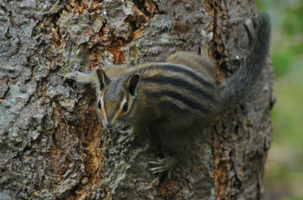Townsend’s chipmunks help to disperse fungi that play an important role in forest nutrient cycles.
Photo Credit: Geoffrey A. Hammerson
Tamias townsendii
Common Name: Townsend's chipmunk
Other Scientific Names: Eutamias townsendii, Neotamias townsendii
Animal Guild: Mammal
Class > Order > Family: Mammalia > Rodentia > Sciuridae
